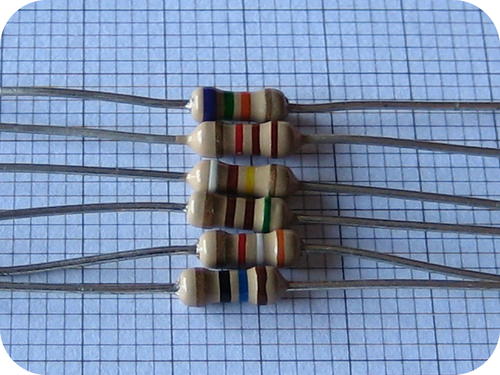百分比错误
章节大纲
-
How does an electrical circuit work?
::电路如何运作?A complicated piece of electronics equipment may contain several resistors whose role is to control the voltage and current in the electrical circuit. Too much current and the apparatus malfunctions. Too little current and the system simply does not perform. The resistors values are always given with an error range. A resistor may have a stated value of 200 ohms, but a 10% error range, meaning the resistance could be anywhere between 180-220 ohms. By knowing these values, an electronics person can design and service the equipment to make sure it functions properly.
::一个复杂的电子设备设备可能包含数个抵抗器,其作用是控制电路中的电压和电流。太多的电流和机器故障。太多的电流和系统故障。太多的电流和系统根本无法运行。抵抗器的值总是有一个错误范围。抵抗器的指定值可能为200 ohms,但误差范围为10%,这意味着抵抗力可能在180-220 ohms之间。通过了解这些值,电子人员可以设计和服务设备以确保其正常运行。Percent Error
::百分比错误An individual measurement may be accurate or inaccurate, depending on how close it is to the true value. Suppose that you are doing an to determine the density of a sample of aluminum metal . The accepted value of a measurement is the true or correct value based on general agreement with a reliable reference. For aluminum the accepted density is 2.70 g/cm 3 . The experimental value of a measurement is the value that is measured during the experiment. Suppose that in your experiment you determine an experimental value for the aluminum density to be 2.42 g/cm 3 . The error of an experiment is the difference between the experimental and accepted values.
::单项测量可能准确或不准确, 取决于它与真实值的距离。 假设您正在做一个测试以确定铝金属样本的密度。 一种测量的公认值是真实值或正确值, 以具有可靠参考的通用一致为基础。 对于铝而言, 接受的密度为2. 70 g/ cm3。 测量的实验值是实验期间测量的值。 假设在实验中您确定铝密度为2.42 g/ cm3 的实验值。 实验的错误是实验值与被接受的值之间的差异。
::错误=实验值 - 接受值If the experimental value is less than the accepted value, the error is negative. If the experimental value is larger than the accepted value, the error is positive. Often, error is reported as the absolute value of the difference in order to avoid the confusion of a negative error. The percent error is the absolute value of the error divided by the accepted value and multiplied by 100%.
::如果实验值低于被接受值,则错误为负值。如果实验值大于被接受值,则错误为正值。通常,错误作为差数的绝对值报告,以避免混淆负错误。百分比错误是错误的绝对值除以被接受值,乘以100%。
::% 错误实验值 - 接受值 接受值×100%To calculate the percent error for the aluminum density measurement, we can substitute the given values of 2.45 g/cm 3 for the experimental value and 2.70 g/cm 3 for the accepted value.
::要计算铝密度测量的百分率误差,我们可以用245克/立方厘米的给定值代替实验值,用2.70克/立方厘米的给定值代替接受值。
::% 错误% 2.45 g/cm3 - 2. 70 g/cm3\ 2. 70 g/cm3\ 2. 70 g/cm3×100\ 9.26%If the experimental value is equal to the accepted value, the percent error is equal to 0. As the accuracy of a measurement decreases, the percent error of that measurement rises.
::如果实验值等于接受值,百分比误差等于0。随着测量的准确性下降,该测量误差的百分率就会上升。Summary
::摘要-
Definitions of accepted value and experimental value are given.
::给出了公认的价值和实验价值的定义。 -
Calculations of error and percent error are demonstrated.
::显示错误和百分比错误的计算。
Review
::回顾-
Define accepted value.
::定义已接受值。 -
Define experimental value
::定义实验值 -
What happens as the accuracy of the measurement decreases?
::随着测量的准确性降低,会发生什么情况?
-
Definitions of accepted value and experimental value are given.
